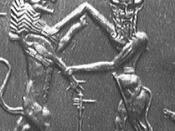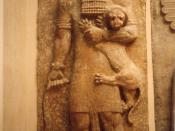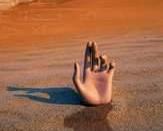Wood � PAGE �6�
Chelsea Wood
World Literature
Dr. Hiortdahl
March 8th, 2014
"The Devil Made Me Do It"
Literary pieces ultimately reveal time-period ideas and cultural values. Most are didactic in nature, teaching the audience the benevolence of goodness and the consequences of evil. Goodness is often depicted as virtuous beings, associated with light and purity. Serving as its foil, are symbols, events, and characters that are the embodiment of evil in its purest form. In literature, the representation of this inherent evil most commonly occurs in the shape of a monster, hideous to behold, oozing of tangible evil, and lurking in the darkness, with claws, horns, and scales, ready to pounce
created to epitomize such evil bent on the destruction of humanity.
The monsters in "Gilgamesh," and "Beowulf," although differing in looks and motivation, can be examined comparatively when considering that often evil creatures cause the hero to act in righteousness and goodness.
In "Gilgamesh," the hero faces two tangible monsters: Humbaba, charged by the god Enlil to be the protector of the forest of cedars, and The Bull of Heaven. Gilgamesh is motivated to kill Humbaba in order to "â¦make the land hear How mighty is the scion of Urukâ¦" and to "â¦wipe out something evil from the land" (p. 48). Although the elders of Uruk advise against the quest, Gilgamesh and Enkidu forge into the forest of cedars and together, they kill the Humbaba, "â¦who was terrifying, whose appearance was horrible, Whose maw was fire, whose breath was deathâ¦" (p. 57), hacking the monster to pieces with a sword "â¦weighing eight times sixty poundsâ¦" (p. 61). After defeating Humbaba, Gilgamesh's physical beauty attracts the attention princess Ishtar, the "Mesopotamian goddes of fertility, sexual love wedlock, maternity, and war..." (The Hutchinson Dictionary of the Arts), who implores...


